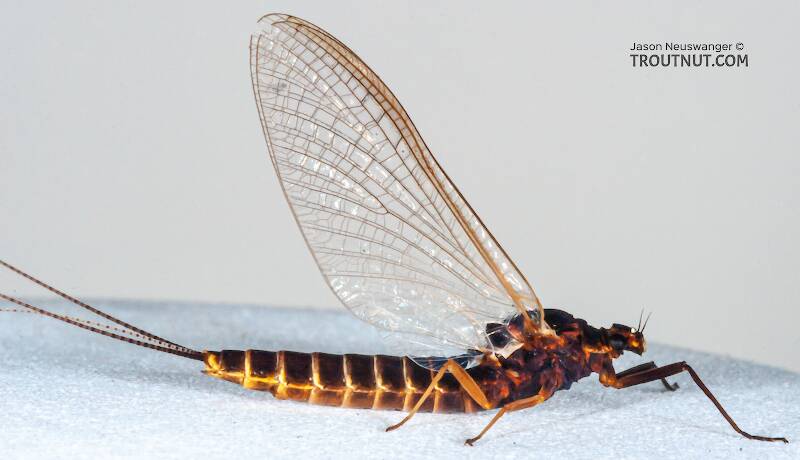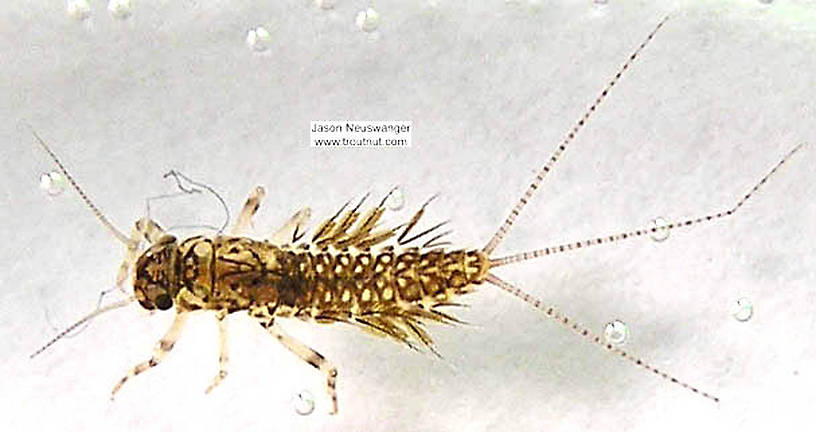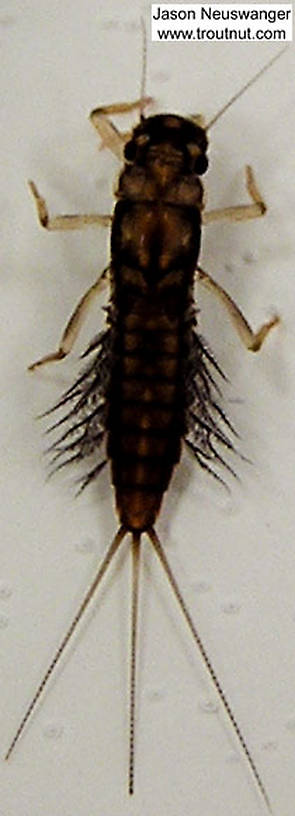
Blue-winged Olives
Baetis
Tiny Baetis mayflies are perhaps the most commonly encountered and imitated by anglers on all American trout streams due to their great abundance, widespread distribution, and trout-friendly emergence habits.
Featured on the forum

With a bit of help from the microscope, this specimen keys clearly and unsurprisingly to Hydropsyche.

Troutnut is a project started in 2003 by salmonid ecologist Jason "Troutnut" Neuswanger to help anglers and
fly tyers unabashedly embrace the entomological side of the sport. Learn more about Troutnut or
support the project for an enhanced experience here.
Blue Quills and Mahogany Duns
Like most common names,"Blue Quills and Mahogany Duns" can refer to more than one taxon. They're previewed below, along with 6 specimens. For more detail click through to the scientific names.
Mayfly Family Leptophlebiidae
These are pretty much always called Blue Quills and Mahogany Duns.
The champions of this family are Leptophlebia and Paraleptophlebia, along with the relatively newly-defined genus Neoleptophlebia containing several important species that were once in Paraleptophlebia. The large mayflies of Leptophlebia are on the water sporadically for a long time. The Paraleptophlebia and Neoleptophlebia flies are smaller but come in much more concentrated numbers.
Leptophlebiidae also contains several genera and species which are never mentioned in fly-fishing literature, either because they are too rare or because they require water too warm for trout.
Leptophlebiidae also contains several genera and species which are never mentioned in fly-fishing literature, either because they are too rare or because they require water too warm for trout.
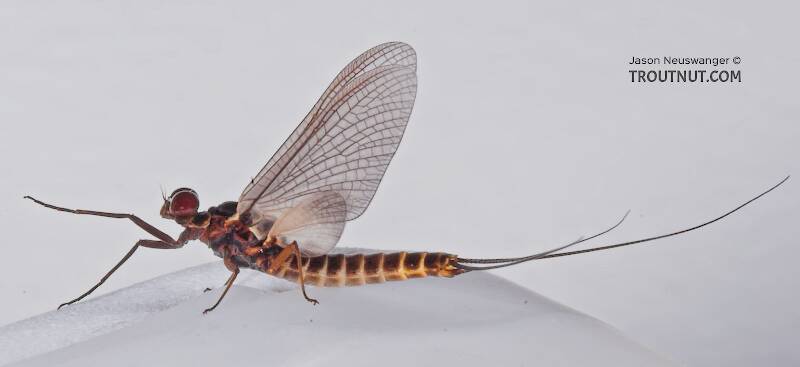
This Leptophlebia cupida dun was extremely cooperative, and it molted into a spinner for me in front of the camera. Here I have a few dun pictures and one spinner picture, and I've put the entire molting sequence in an article.
See 63 more specimens...
Mayfly Genus Paraleptophlebia
These are pretty much always called Blue Quills and Mahogany Duns.
There are many species in this genus of mayflies, and some of them produce excellent hatches. Commonly known as Blue Quills or Mahogany Duns, they include some of the first mayflies to hatch in the Spring and some of the last to finish in the Fall.
In the East and Midwest, their small size (16 to 20, but mostly 18's) makes them difficult to match with old techniques. In the 1950s Ernest Schwiebert wrote in Matching the Hatch:
Fortunately, modern anglers with experience fishing hatches of tiny Baetis and Tricorythodes mayflies (and access to space-age tippet materials) are better prepared for eastern Paraleptophlebia. It's hard to make sense of so many species, but only one is very important and others can be considered in groups because they often hatch together:
In the East and Midwest, their small size (16 to 20, but mostly 18's) makes them difficult to match with old techniques. In the 1950s Ernest Schwiebert wrote in Matching the Hatch:
"The Paraleptophlebia hatches are the seasonal Waterloo of most anglers, for without fine tippets and tiny flies an empty basket is assured."
Fortunately, modern anglers with experience fishing hatches of tiny Baetis and Tricorythodes mayflies (and access to space-age tippet materials) are better prepared for eastern Paraleptophlebia. It's hard to make sense of so many species, but only one is very important and others can be considered in groups because they often hatch together:
- Paraleptophlebia adoptiva is by far the most important species of this genus in the two regions and is an early Spring emerger.
- Paraleptophlebia mollis, Paraleptophlebia guttata, and Paraleptophlebia strigula complement each other in late spring and early summer.
- Paraleptophlebia debilis and Paraleptophlebia praepedita occur together in the fall.
- The most important species is Paraleptophlebia debilis. This large (for the genus) Fall emerger can be found throughout the region. It is often accompanied by one of the slightly larger tusked species. Depending on locale, this can be Paraleptophlebia bicornuta (the most common), Paraleptophlebia packii or Paraleptophlebia helena. Check out their hatch pages for distribution information.
- Spring is the season for the smaller Paraleptophlebia heteronea throughout most of the region with Paraleptophlebia gregalis filling this niche in California and parts of Oregon.
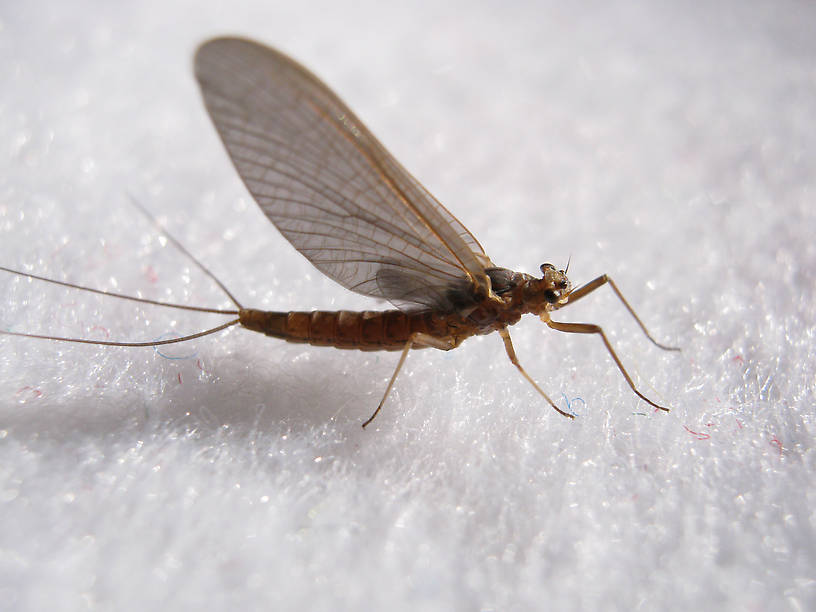
Size: 9mm. These photos really highlight the brown pigmentation of the wing venation, but in the hand the wings look to be a uniform smokey gray. - Entoman

This specimen (and a few others I collected but didn't photograph) appear to represent the first finding of Paraleptophlebia sculleni outside the Oregon Cascades, although it is not a monumental leap from there to the Washington Cascades. The key characteristics are fairly clear.
See 18 more specimens...
References
- Schwiebert, Ernest G. 1955. Matching the Hatch. MacMillan Publishing Company.


